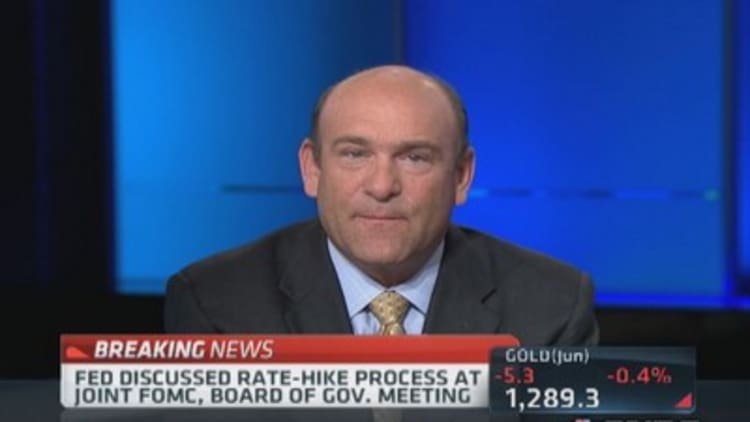
Federal Reserve officials discussed rate hike procedures at a joint meeting, but agreed the discussion does not signal rate action is coming soon.
That was one of the key data points from the minutes of the FOMC meeting, released Wednesday.
The Fed discussed the right mix of tools to control rates and board members agreed a mix of tools is likely needed to normalize rates.
"Participants generally agreed that starting to consider the options for normalization at this meeting was prudent, as it would help the committee to make decisions about approaches to policy normalization and to communicate its plans to the public well before the first steps in normalizing policy become appropriate," the minutes said.
Read MoreKoherlakota: Inflation a significant problem
To investors, "normalizing" means winding down the monthly bond buying program and raising short-term interest rates from near-zero levels.
Intermittent comments from various Fed officials indicating that a rate increase could happen sooner than expected have rattled investors; the release of the minutes did nothing to shake a full-force rally in the stock market, indicating Wall Street is comfortable that the central bank is not prepared to enact any significant tightening measures.
Fed officials apparently are paying attention to the impact their comments are having. Fed Chair Janet Yellen rattled investors in March when she indicated that a rate increase would happen six months after the bond-buying program—quantitative easing—ended, prompting speculation that the timeline had moved up for monetary tightening.
"Federal Reserve communications garnered significant attention from market participants over the period but appeared to have only a modest net effect on their expectations for monetary policy," the minutes said.
"The communications following the conclusion of the March FOMC meeting were interpreted as somewhat less accommodative than expected. However, subsequent communications—including the release of the minutes of the March FOMC meeting—appeared to reverse the earlier change in expectations."
Open Market Committee members also offered various reasons for the decline in longer-term bond yields, though none of them involved an economic slowdown. They instead attributed the move to "portfolio reallocation by large institutional investors, the trading strategies pursued by some investors, and safe-haven flows."
A number of meeting participants also cited potential risks to growth ahead, including the housing sector, the cooling Chinese economy and unrest in Ukraine.
The committee said described financing conditions in commercial real estate as "improved further" but said mortgage credit "remained tight...though signs of easing continued to emerge amid further gains in house prices."
Read MoreConsumer creditdefaults at pre-recession levels
The housing weakness came primarily due to "higher home prices, construction bottlenecks stemming from a scarcity of labor and harsh winter weather, input cost pressures, or a shortage in the supply of available lots."
As for broad economic conditions, the Fed deemed the no-growth first quarter "transitory."


